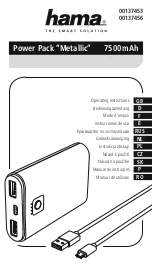
Surface Technology
Oberflächentechnik
i
10
Describing of the operating elements of the control unit
Figure 7.1/1:
Handpiece holder takes up the handpieces.
Figure 7.1/2:
Forward/reverse selector switch
Select the direction of rotation with the forward/reverse selector switch. Each
time this switch is pressed, the direction changes. When the FWD./REV. is not
lit, it shows right hand rotation (FDW.).
Figure 7.1/4:
The rotating regulator allows the rpm of the relevant micromotor to be infi nitely
varied up to the maximum level 40,000 rpm (is equivalent to 40).
Figure 7.1/5:
Memory Speed Function, Fixpeed
First with the motor stopped, preset the desired speed on the speed control
knob(7.1/4). Next press the fi xpeed switch for more than 1 second . A „beep“
sound and the fi xpeed LED will light. The motor is now set to run at the fi xpeed
setting. To change fi xpeed memory, repeat the above procedure.
Fixpeed memory cannot be set over 30,000 rpm!
Next press the memory function key for more than 1 second. A signal sounds and the LED display
(7.1/6) illuminates. The rpm now remains constant at the saved speed. One speed and one direc-
tion of rotation can be saved for each motor output, which is also retained after switching on the
control unit again:
•
select the appropriate motor (7.1/14 or 7.1/10)
•
adjust the speed (7.1/4)
•
observe direction of rotation (7.1/2)
•
press the memory key for more than 1 second.
The saved speed can be deleted by further pressing the memory key for more than 1 second. A
signal sounds. The LED display (7.1/6) is no longer illuminated.
When the ENESKA 3-2 system is shipped from the factory, the fi xpeed is preset for both
motor A and B to 20,000 rpm.
If the foot pedal is used, the speed range can be varied with a saved rpm up to the set speed.
Figure 7.1/7:
Mains switch for switching the power supply On/Off
Figure 7.1/8:
Support
After loosing the hand screws on both sides, the support arm can be
pivoted into diff erent resting positions.
Figure 7.1/15 and 7.1/9: Connection sockets A and B for plugging in the connecting cable
with corresponding micromotors. The speed set accordingly for the
connected micromotor appears on the speed display (7.1/4).
The micromotors connected to both connection sockets A and B cannot be operated simultane-
ously.




































